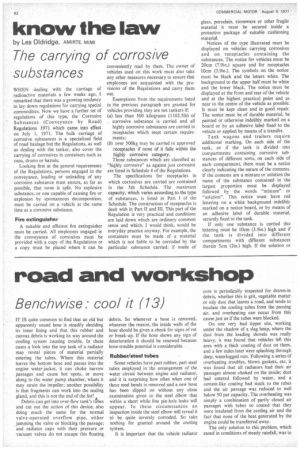road and workshop
Page 64

Page 65

If you've noticed an error in this article please click here to report it so we can fix it.
by Handyman
Benchwise: cool it (13)
IT IS quite common to find that an old but apparently sound hose is steadily shedding its inner lining and that this rubber and canvas debris is working its way around the cooling system causing trouble. In these cases a look into the top tank of a radiator may reveal pieces of material partially entering the tubes. Where this material leaves the bottom hose and passes into the engine water-jacket, it can choke narrow passages and cause hot -spots, or move along to the water pump chamber, where it may strain the impeller; another possibility is that fragments can work into the sealing gland, and this is not the end of the list! •
Debris can get into over-flow tank's tubes and cut out the action of this device, also doing much the same for the normal valve-operated overflow pipe, either jamming the valve or blocking the passage; and radiator caps with their pressure or vacuum valves do not escape this floating debris. So whenever a hose is removed, whatever the reason, the inside walls of the hose should be given a check for signs of rot or break-up. If the hose shows any sign of deterioration it should be renewed because hose-trouble potential is considerable.
Rubber/steel tubes Some vehicles have part rubber, part steel tubes employed in the arrangement of the water circuit between engine and radiator, and it is surprising how often when one of these steel bends is removed and a new hose has been slipped on without any close examination given to the steel elbow that within a short while fine pin-hole leaks will appear. In these circumstances an inspection inside the steel elbow will reveal it to be quite severely corroded. So take nothing for granted around the cooling system.
It is important that the vehicle radiator core is periodically inspected for drawn-in debris, whether this is grit, vegetable matter or oily dust that leaves a road, and tends to insulate the cooling tubes from the passing air, and overheating can occur from this cause just as if the tubes were blocked.
On one very bad tipper site, working under the shadow of a slag heap, where the dust from the loading shovels was really heavy, it was found that vehicles left this area with a thick coating of dust on them, and a few miles later were splashing through deep, waterlogged ruts. Following a series of overheating troubles, blown gaskets, etc, it was found that all radiators had their air passages almost choked on the inside; dust had entered followed by water, and a cement-like coating had stuck to the tubes and the air passage was reduced to well below 50 per capacity. The overheating was simply a combination of partly closed air passages with tubes so coated that they were insulated from the cooling air and the fact that none of the heat generated by the engine could be transferred away.
The only solution to this problem, which eased in conditions of steady rainfall, was to arrange a nightly exercise of cleaning out the air passages in readiness for the next day. In some instances air pressure and a water hose would do the trick, in others steam was used, and the worst cases had to have treatment from an electric drill fitted with a long, wire de-coke brush. The immediate decrease in overheating trouble well justified the expenses of the fitter and service vehicle that had to come out to the site on overtime.
Consideration was given to various shields and dust-guards, but nothing would stop the dust penetrating, and since there was already an air cleaner service every 24 hours the two duties were brought together as one, but the front grilles were left off the radiators to both cut down cleaning time and permit all possible air to enter. This exercise of rad core cleaning created some friction with the operating section, who complained that its cost was eroding an already slim profit margin, but it was soon learned that the alternative would be delay and mechanical expense, and that the only cure was prevention.




























































































































